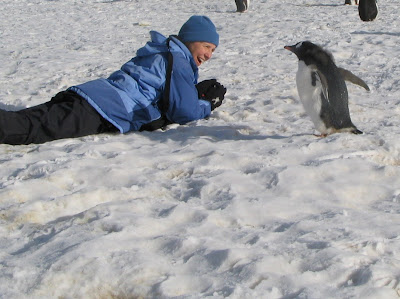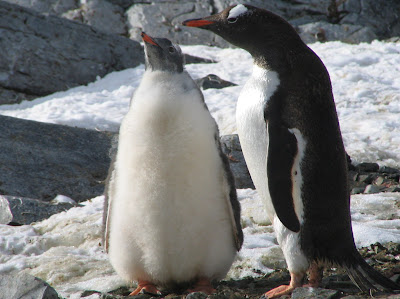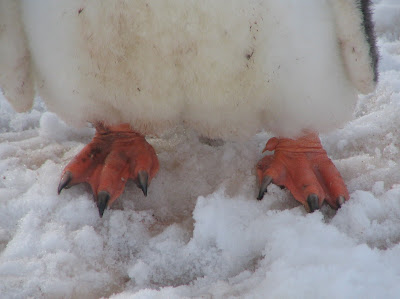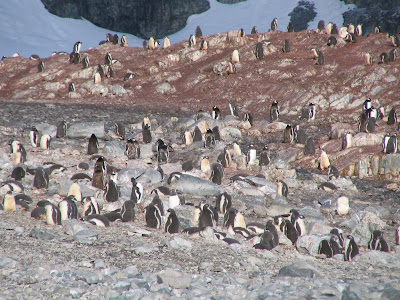If yesterday was “Whale Day”, today was going to be the “Day of the Penguins”. We have cruised overnight from Wilhelmina Bay south into the Errera Channel, and have anchored there. The morning excursion is to Cuverville Island, home to a huge Gentoo Penguin rookery. A 10-minute zodiac ride brings us to the island. As we approach, we can see hundreds, then thousands, of dots on the beach and surrounding rocks. Penguins. We will soon be immersed in a huge penguin population, and laugh about our excitement over the last couple of days when we have gotten a view of an individual penguin or two.
As we make landing, several things hit us.
-First, the scale of what is in front of us. There are penguins everywhere! As far as we can see in either direction along the shore, and up on the rocks and hillsides above us, there are penguins. We read that there were about 4000 nesting pair on this island, but at this point there is also a huge population of young chicks, about 2 ½ months old now (born in December) and almost adult size, so I suspect the numbers now are at least 10000-15000 birds. We are seeing just a subset, albeit a large and impressive one, of this number.
-Second thing to hit us was…. The smell. The place stinks of a putrid, rotting marine smell. After a while we get used to it, but it is overpowering at first.
-Third thing: We realize that that the orange tinge to the rocks around us is due to the fact that these penguins are living in a tremendous penguin latrine. There is penguin crap everywhere. The birds, when you look at pictures of them, look cute and cuddly, but they live in what most people would consider to be less-than-idyllic conditions.
-Fourth thing: the sounds. There is a constant din of penguin chirps and warbles and squawks and clucks. They sound similar to sea gulls, but a bit softer in tone.
We walk slowly up onto the rocks, taking in our surroundings in amazement. We are told to move very slowly, and to obey the 5-meter rule (from the Antarctic Treaty agreement). That states that you should never approach an animal closer than 5 meters (about 15 feet). It’s hard to do here, because of the density of the penguin population, but you just adhere to the spirit, rather than necessarily the letter, of the law in this case. We use common sense and just avoid appearing aggressive to these animals. The suggestion was that we squat or lie down, and let them come to us. So Joan and I move up and onto a patch of snow that looks relatively clean, and take turns lying down, while the other has the camera to record the interactions.
Most of the birds around us are actually chicks, as opposed to adults. You can easily distinguish them. The adults are sleek, with their black backs well defined and dark. The chicks are fuzzy and downy, puffy almost to the extent of appearing larger than the adults. Their colorings are not so well defined. Their darks spots are more like a gray, and the lines between white and dark feathers are not so distinct. The young birds seem particularly curious, and it is not long before they approach us. One in particular approaches Joan, looks her in the eye, and then lies down in the snow right next to her head. One of the cutest moments on record! He lies there for a while, then gets up, flaps his wings, and moves on.
We switch roles, and I lie down and attract two young birds to me. I slowly pull out Rocky, our toy penguin mascot, from my pocket, and put him down in the snow next to me. The birds stand next to my outstretched legs, notice Rocky, and bend down to give him a very careful look. Joan snaps some classic pictures of this moment.
As we land, we get our first views of hundreds, and if we look to the distant hillsides, thousands, of penguins that are on this island. The pink color on the rocks is penguin guano, colored that way by the shrimp-like krill that makes up their diets.

The adult birds all seem to be on the go. They make continual trips out into the water to collect food, then back to their nesting areas to feed their chicks.

The chicks, meanwhile, spend their time in groups, waiting for their parents' food deliveries.




Joan and I take our turns, laying down in the snow to attract the attention of the birds around us. In only a few moments, we have visitors. The sequence below documents Joan's interaction with a new friend.






And this sequence shows Mike's & Rocky's penguin playtime.






I could not resist taking this shot. Rocky is set in the snow in the foreground, with Cuverville residents in the background. Rocky fits in pretty nicely, doesn't he?!

Then we wander around the island to just take things in. Looking out over the bay, the surrounding mountains form a spectacular backdrop for the Penguin colony in the foreground. A line of low peaks on the other side of the channel are on the mainland of the Peninsula, with a far, distinctive peak rising about 1000 feet above the water. We later learn from maps that this is Spigot Peak. Jacques Sirois, the bird expert on this expedition, is out here with us, and we talk with him for a while and learn a lot. For example:
-The young penguins are still not ready to go out into the water. The life of the adults is to swim out into the water, eat their fill of krill (shrimp-like marine animals), come back to their nest and feed their young by regurgitating the krill into their chicks’ mouths. (We see this taking place all over…. The young birds put their heads up entirely into their parents’ open mouths, so that it looks like the adult is biting off the head of the young!)
-Aside from this being a lot of work, there is one other danger for the adults on these food gathering trips… leopard seals. This is the one dangerous carnivore in Antarctica (dangerous to some extent even for people), and they will cruise the waters off the beaches, waiting for the adult penguins to swim by and provide them their meals. In fact, Jacques tells us that the passengers on the first zodiac to the island this morning witnessed a leopard seal killing a penguin. We heard about it in more graphic details later in the day from some who were on that zodiac.
-The adults will feed only their chicks, not their neighbors. So, if the parents are killed by a leopard seal, for example, their chicks will starve to death. The chicks are also vulnerable, especially when they are small, to Skuas and other birds that will prey on them. Mortality rate for young penguins from all these causes is about 50%.
-This is about the time of year when the adults molt. We see a number who are beginning, looking pretty shabby as their feathers begin to drop.
-Many of the penguins roost in the rocks way up on the hillsides. (We will see even more dramatic examples of this this afternoon.) Why would they choose such obviously inconveniently located spots if they must constantly make trips to the water to get food for their young? The answer: They look for the spots in spring that are clear of snow to build their nests. Here, the tops of the hills are the first areas to clear of snow … greater sun exposure, and the effect of winds that clear the snow at the higher elevations. So picking these spots enables the birds to get started on their nesting sooner. Now, late in the summer, they would probably have preferred a location closer to the shore, but they just stay with what they have established.
-Many of the penguins roost in the rocks way up on the hillsides. (We will see even more dramatic examples of this this afternoon.) Why would they choose such obviously inconveniently located spots if they must constantly make trips to the water to get food for their young? The answer: They look for the spots in spring that are clear of snow to build their nests. Here, the tops of the hills are the first areas to clear of snow … greater sun exposure, and the effect of winds that clear the snow at the higher elevations. So picking these spots enables the birds to get started on their nesting sooner. Now, late in the summer, they would probably have preferred a location closer to the shore, but they just stay with what they have established.
As we walk with Jacques he notices two large boluses of krill on a rock. Evidence that one of the young chicks must have been disturbed by someone getting too close, and did not keep his food down. But it proved to be an excellent chance to see up close the food that these guys eat. It was a ball, perhaps an inch and a half in diameter, of wadded up krill.
We wander in appreciation until the last of the zodiacs are ready to leave, and we get on board to head back to the ship. However, our morning’s adventures are not quite over. As we pull away from the shore, our driver spots a leopard seal a short distance away in the water. We quickly scan the waters to see if any penguins are swimming this way, wondering if we are about to witness a “National Geographic moment”, be we see none. Out come the cameras, as the seal surfaces and dives repetitively all around us. He disappears, and then bobs up in a different spot, and disappears just as the cameras are about to focus on him. Like a twist on a “whack-a-mole” game, never being sure where he will pop up next, it proves to be a very frustrating picture taking experience, but it is great to see one of these creatures up close. Actually, they seem to have a very sleek, docile looking face, and it is a bit hard to imagine them in their role at the top of the food chain here.
Additional photos from Cuverville Island:


The next two pictures provide a good comparison between adult birds and chicks. The adults are sleeker, and the coloration is distinct - clear lines between dark and light. Their torsos are more developed across the chest. The young birds are puffed out with downy feathers. The dark areas are grey, not black. And more of their weight is in their bellies.


A mother feeds her young chick by regurgitating krill that she has collected in the waters around the island.

An adult bird, moulting its feathers -- a routine process at this season.

Adult birds at the water's edge.

Jacques Sirois, one of the expedition's naturalists, and an expert on birds. We learned a lot from him.

A pair of chicks, enjoying the security of one another as they sleep. (This is a good photo to click to see larger. Then, just hit the "back" arrow in your browser to return here.)

Joan, surrounded by whale bones. A number of such bones are scattered along the shoreline. These may be remnants of a whaling industry that existed here years ago, before the International Antarctica Treaty outlawed such activities.


The distinctive Spigot Peak, the triangular peak to the left.

As we boarded our zodiac and prepared to leave the island, a leopard seal appeared in the water. He moved so quickly and unpredictably, mostly staying submerged but popping up for short moments here and there. This was the only photo I could get, of his body as he was diving back under water. Leopard seals are carniverous and feed on penguins, so this is a prime spot for him. Larger leopard seals have been known to attack and kill humans.
We get back to the boat in time for a special lunchtime activity. This afternoon, the Ioffe will host the official marathon celebration and awards ceremony. The Vavilov has appeared and has docked a short distance away, and its passengers have been ferried by zodiac to our ship, and we have the entire marathon community from both ships out on our open deck for a major cookout. Hamburgers and hotdogs, chicken and ham, lots of veggie trimmings, and two large cakes baked in the shape of the Ioffe and the Vavilov. Beautiful blue waters, snow capped mountains, and blue sunny skies all around. Could have been a summertime picnic in the U.S., except that we are on a Russian icebreaker, and we all have our coats on.
While the festivities are going on, I use the opportunity to get time on the computer. Yes, there is a laptop computer provided on board the ship, and made available to passengers to manage their digital pictures. As many of us are beginning to get worried about running out of capacity on our camera memory cards, this provides the opportunity to copy our pictures onto a CD. As the computer is heavily in demand, it takes a time like this, or during the middle of the night, to be able to get the access needed. I successfully copy all pictures over, and burn a CD, so that now if push comes to shove, I can erase one of our cards for additional capacity later in the trip. With the CD of our pictures in hand, it is good to know that I will not have to hold back on picture taking for the rest of the trip! Mind at ease, I go out and grab some food. Then, we go back to our cabin and catch a nap.
Deck Party: The combined group of passengers from the Vavilov and the Ioffe meet on the Ioffe to enjoy a celebration, a marathon awards ceremony, a cookout, and some pretty terrific scenery.



This afternoon, excursion #2 is also penguin-oriented, but on a different island, Danco Island, a short distance from the boat in the other direction from Cuverville. Here is another large colony of Gentoos, not as large a group as on Cuverville, but still very impressive. The notable thing about this island is the very high hill…. Perhaps 500 feet up above the water. We trudge up, with some effort, to make it to the top, and look out over the bay, and at our ship like a toy below. This provides some nice photo ops for us, and we have our picture taken by fellow travelers, with the impressive backgrounds behind us. It is also here that we fully appreciate the nature of the penguins roosting on high ground. Many nests are up on the hilltop, meaning that the penguins have to make the repetitive trip down for food, and then back up this hill to feed their young. What a tremendous effort to go through for routine feeding! There is a penguin highway that has a pretty steady stream of traffic up and down, and we marvel at the fact that these birds manage that routine successfully.
After landing on Danco Island, we climb the steep hill. Near the top, we have our photo taken, looking down on us and the scene below. Seeing the Ioffe anchored in the bay far below helps you appreciate the height of this hill.

There are hundreds of nesting areas up here, and the climb we just made is what these penguins must do all the time. There is a main path, a virtual penguin highway, going up this hill, and there is always penguin traffic on it.... adult birds having filled themselves with krill in the waters below, and now bringing it up the 500 feet to feed their offspring.


Often, penguins are traveling in ones and twos, but sometimes we see larger groups of them, usually traveling in single file, making the trek up or down the hill.

Once at the top of the hill, we enjoy wandering around, just looking for the interesting picture to take.





Back to the ship, and dinner. We now feel like we have experienced, and know something about, Gentoo Penguins!
Now, this is the night that we had been considering our other seemingly impossible activity. The night when people are given the opportunity to camp out overnight on the snow. This is basically what it sounds like…. Sleeping in a sleeping bag, directly in the snow. No tents…. They would probably just blow away anyway in the typical Antarctic winds. We had really wanted to experience this, but now, we waiver, and then decide not to do it. My respiratory infection is the main reason for me…. I spoke to Dr. Ivy, and she said: a) probably wouldn’t kill me, but not the best thing in the world either; and b) most healthy people on these overnights start getting pretty cold, and start REALLY looking forward to getting back on board the ship by about 3 or 4 in the morning. That last part did not sound like fun to Joan either. About 75 people had expressed an interest in this, so we watch these bold souls claim sleeping bags from the pile made available by the staff, and head out for their zodiac ride into the night and on to Ronge Island. When all the campers had left, there remained a pile of about 25 unclaimed sleeping bags, indicating the number of people who had changed their minds and decided to camp out on the Ioffe instead! We go back to our cabin and climb into our nice warm covers, and go to sleep, a little disappointed, but not that much!






No comments:
Post a Comment